Submission on Te Muri draft management plan variation
As submitted 18 March 2016, except where noted.
Executive summary added 26 March 2016
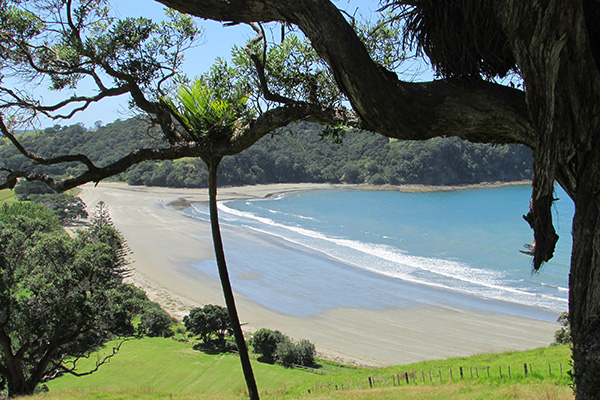
End of the Isolation: The sense-of-splendid-isolation era that Te Muri currently enjoys is coming to a close. But whether what comes next is a 1960s car-centric Long Bay, or a vision of regional parks for the next 50 years will depend upon the response of Auckland Council this and 300 other submissions. image Chris Eddy
The following is Mahurangi Action Incorporated’s submission, as lodged in PDF format on 18 March, but without the executive summary provided here.
In the pursuit of transparency, this submission was published in instalments as a work in progress as each section was developed, with readers—whether members of Mahurangi Action or otherwise—invited to comment. On Monday 21 March, Auckland Council was supplied with a high-resolution version of the submission lodged, which at 13.1 megabytes had been too large to email ahead of the 4 pm Friday deadline.
Contents
- Introduction
- Wider context
- Fewer is greater
- Exploring Te Muri
- Te Muri a beach to protect
- Primacy of picnicking Te Muri
- Camping Te Muri-style
- Mahurangi Coastal Trail
- Te Araroa, the local walkway
- Mahurangi Regatta Week
- Indigenous farm-forestry
- Mahurangi marine reserve
Executive summary
Above all, it must be a plan for the next 50 years.
Coinciding as it does with the Auckland Regional Parks 50th anniversary, the regional parks management plan variation in respect to Te Muri has a duty, at the very least, to demonstrate mindfulness of the challenges of the next half-century.
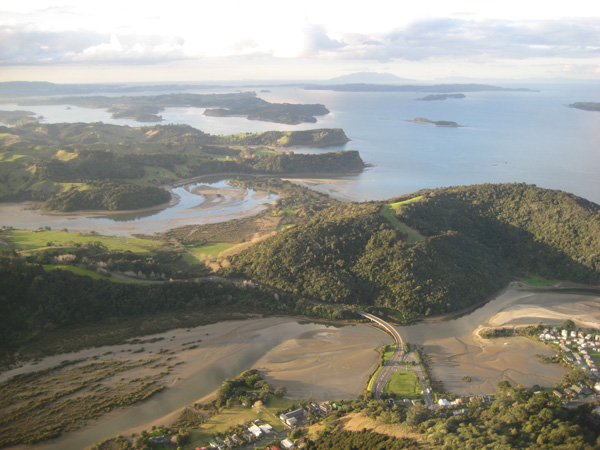
Greater Mahurangi Regional Park: Most of the deficiencies of the draft regional parks management plan variation stem from its failure to see Te Muri in the context of the greater Mahurangi regional park, which spans much of the land discernible in this image. The northern terminus of Auckland’s metropolitan transport system, visible in the foreground, is an attribute that a low-carbon Auckland simply cannot ignore. image ImageShack
But more than merely demonstrating awareness of the unfolding global climate emergency, the development of Te Muri deserves to be an exemplar of how regional parks can better meet the needs of a rapidly growing and intensifying, zero-carbon metropolis. In this submission, Mahurangi Action sketches out how an alternative to the car-centric model that perpetrates 1950s thinking can, considerably more affordably and sustainably, make regional parks more accessible to more Aucklanders, and improve public health outcomes.
Mahurangi Action principally proposes:
- Treating Te Muri as part of a greater Mahurangi regional park
- Development that ensures the 95% of Te Muri that is steep hill country is not underused, and that the finite and sea-level-rise threatened 5% that is coastal and estuarine terrace is protected and not overused
- Connectivity to the metropolitan transport system at Waiwera
- Providing initial primary access via a Mahurangi Coastal Trail
- Facilitating the creation of a missing terrestrial Pūhoi–Te Muri section of Te Araroa, the national walkway.
The draft variation treats the new acquisition as though it was a separate, discrete regional park. This manifests in a focus on providing access separately, from State Highway 1, rather than more quickly and affordably from the immediately adjoining Mahurangi and Wenderholm regional parks.
There is no question that, if the intersection of State Highway 1 and Hungry Creek Road, Hungry Creek Road itself, and the Schischka farm road were all upgraded, at a probable cost of at least $10 million, to allow private vehicle access, people would flock to Te Muri Beach. This, however, would take at least a decade to implement, require a more accommodating fiscal environment than the present, and would shatter the sense of splendid isolation that generations of Te Muri users have enjoyed.
The alternative vision that Mahurangi Action lays out here seeks to use the allure of a less crowed beach, and its greater isolation, to encourage park visitors to explore and use the 383-hectare Schischka farm purchase. If, as the draft variation proposes, visitors were fast-tracked to the beach by a $10 million park driveway, scant incentive would remain to induce those visitors away from the beach, particularly given the initial uphill slog involved. Instead, the majority of visitors to Te Muri would start their journey at Waiwera or at Wenderholm, and walk in using the proposed Judge Arnold Turner Footbridge. Depending upon the route taken, an undemanding, family-friendly 40-minute walk would be involved, or, if approached from Mahurangi West, a little more than 10 minutes.
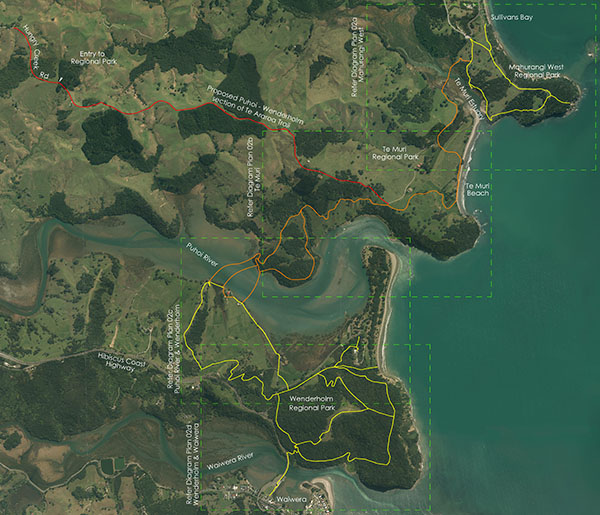
Epitome of Accessibility: With Wenderholm to the south and the Mahurangi park just across the Pūhoi River, all that stands between Te Muri and regional park visitors is the lack of a footbridge— the Judge Arnold Turner Footbridge. map Parallax Surveyors and Planners
Serendipitously, Waiwera, the northern terminus of the metropolitan transport system, is already connected to the southern limit of the greater Mahurangi regional park by footpath. Providing public transport patrons with the first-class means of accessing Te Muri, via Wenderholm and the Judge Arnold Turner Footbridge, rather than the default response of prioritising private vehicle users would be entirely in line with the council’s Low Carbon Auckland action plan, which correctly concentrates on the 39% of greenhouse gas emissions that emanate from the city’s transport—the largest single source.
Equally serendipitous is the opportunity to facilitate a new Te Araroa section that would link Pūhoi and Te Muri. At present, the official route is the Pūhoi River, which while wonderful for those able to take advantage of a favourable tide, at present relegates most walkers to the shoulder of State Highway 17. The submission by the Pūhoi Community Forum fulsomely makes the case for their village being the staging point for Te Muri visitors approaching from that direction, including horse riders, approaching from the west. Whereas the existing car-centric model of regional parks access all but eliminates the opportunity, and certainly the incentive, for park users to interact with local economies.
Te Muri provided the principle location for the beach scenes in the 1991 film End of the Golden Weather, the Ian Mune adaptation of Bruce Mason’s one-man loss of innocence play, sans the inconvenient Great Depression dimension. It would be monumentally tragic and ironic if the development of Te Muri contributed to, rather than delayed, the loss of this and ultimately all beaches. The Auckland Regional Parks 50th anniversary demands a plan for Te Muri that is fit for the challenges of the next 50 years.
Mahurangi Action asks that Te Muri, with the community’s help, be opened quickly and affordably with a footbridge—the Judge Arnold Turner Footbridge—at a fraction of the cost of road access, and in a fraction of the time.
About Mahurangi Action
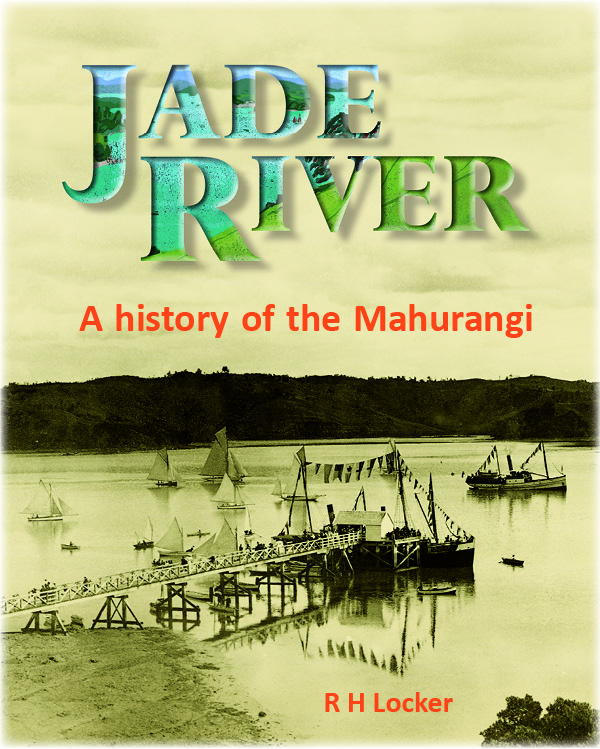
Labour of Love: ‘In truth, the real excuse for this book is that it is a labour of love, a kind of payback for all the pleasure the river has given me. The writing of it has proved to be an extension of that pleasure. It is the crystallisation of a longtime hazy idea, made possible by time available in retirement.’ Dr Ron Locker 1994
Established in 1974 as Friends of the Mahurangi, Mahurangi Action Incorporated’s purpose is to take actions to enhance, protect and restore the environment of the Mahurangi for the benefit and enjoyment of the general community.
‘The Mahurangi’ has rather blurred boundaries. The Mahurangi Purchase, completed in 1854, spanned from Te Arai Point in the north, to the northern shoreline of the Waitematā. The area referred to by the settlers as Mahurangi, however, was much smaller, as Dr Ronald Locker, in Jade River : A History of the Mahurangi, states:
The Bay (or Bight) of Mahurangi meant to early [European] mariners, the enclosed waters from Kawau to Tiritiri Matangi.
The area generally considered to be Mahurangi has probably shrunk, but the circulation area of local newspaper Mahurangi Matters extends from Mangawhai in the north, south to the Waiwera River, at which point its sister title, the Hibiscus Coast Matters takes over. Off Waiwera, or more properly, off Maungatauhoro, is Mahurangi Island, which holds the Mahurangi line in the south, and gives credence to Te Muri, unambiguously, being part of Mahurangi.
Although Mahurangi Action’s foundation issue was the inadequacy of the then Warkworth Town Council’s plans for its wastewater treatment, the organisation has always been about the enjoyment of the Mahurangi Harbour and its environs. Thus it revived the Mahurangi Regatta, in 1977, the event having lapsed during World War II. The society’s more significant achievements include:
- 2001
- Publication of Dr Ronald Locker’s 416-page Jade River : A History of the Mahurangi
- 2002
- Successful High Court defence of the public’s entitlement to access Jamieson Bay
- 2007
- Establishment of scientifically designed trials demonstrating that forestry-style nursery methods could slash the cost of raising indigenous plants
- 2012
- With property holder, establishment of the Mahurangi Farm-Forestry Trail
- 2015
- Warkworth Sediment Improvements Pilot
Mahurangi Action’s secretary is a 69-year-old founding member, and the president, as of November 2015, is a 21-year-old sportswoman and entrepreneur. Committee members include an engineer, a lawyer, a marine biologist cum oyster farmer—one of New Zealand’s largest producing, and a 20-year-old sound technician.
Return to Contents
1 Introduction
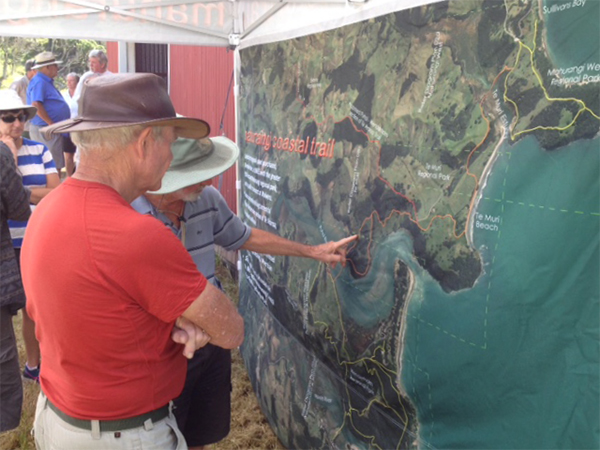
Mahurangi Action’s new regatta entries tent, with its wall displaying a large-scale map of the Mahurangi Coastal Trail, was spectacularly successful, deployed at the entrance to the woolshed during the official walk-in open day examining the draft management plan variation in respect to Te Muri. The entries tent is principal Mahurangi Regatta sponsor Teak Construction’s 2016 contribution to the Mahurangi community. image Bronwen Turner
The timing of the Auckland Regional Parks management plan variation in respect to Te Muri, coinciding as it does with the regional parks 50th anniversary, presents Auckland Council with an historic opportunity to demonstrate understanding that the world being planned for today is very different from that in 1966, when Aucklanders were enjoying their first summer’s access to Wenderholm Beach.
In the mid-1960s, the Master Transportation Plan for Metropolitan Aucklandincorrectly rendered as Auckland Transport Masterplan in submission was basking in its first decade of supremacy in ensuring that regional transport was all about road transport. It was the end of the line for rail and light rail—petrol-powered cars, and diesel-powered trucks and buses were the future, and the more miles that could be driven without leaving the motorway the better. And this was the world in which Auckland’s regional parks network was conceived and born, with the 30 March 1965 purchase of Wenderholm.
As if the Auckland Regional Parks 50th anniversary, marked by the opening of Wenderholm to its public on 18 December wasn’t sufficient cause to consider the needs of the next 50 years when planning Te Muri’s development, the Paris Agreement, the culmination of 23 years of climate talks one week earlier certainly is. But what was always obvious about Paris, regardless of how many of the 195 participating states sign, much less ratify the climate agreement, is that it will mean nothing if it results in little more than an acceleration in the uptake of electric cars and roof-top photovoltaic panels—a patently inadequate response, and one with negligible potential to avert dangerous global warming.
In a bracing post-Paris article in the Guardian, Dr Ian Walker and Gus Bosehans challenge the persisting car-centric thinking:
Aside from climate action necessarily being the existential priority consideration of every planning and policy decision that is now made, as Walker and Bosehans allude the only intervention that has been found to be significant in responding to the developed and developing world’s epidemic of noncommunicable diseases is the prioritising of public transport. It seems that the few extra steps that users of public transport are required to make bestow a slew of cascading health benefits.
The draft variation, in respect to Te Muri, exhibits an entirely appropriate preoccupation with the need to realise the potential of the $15 million purchase of the 383-hectare Schischka farm in 2010. But the proposed development largely treats the new parkland in insolation of the balance of the greater, 900-hectare Mahurangi regional park estate, and makes the self-fulfilling assumption that visitors will access Te Muri by car. Mahurangi Action urges that a very much wider context needs to be considered, including the following:
- The international agreement to pursue efforts to limit global average temperature increase to 1.5°
- The importance of tourism to the economy of Aotearoa, and the importance of Auckland Regional Parks to the regional and to local economies
- National walking access goals and the need for Te Araroa, the national walkway, to be supported and complemented
- The public health benefits of facilitating and incentivising walking, cycling and horse riding
- The region’s projected population increase of one million over the next 30 years, and the challenge this poses regional parks
- The imperative to plan for the entirety of the greater Mahurangi regional park estate.
Before descending into the detail of the Mahurangi Action submission, much less its responses to the specifics of the draft plan, the six aforementioned contextual considerations will be briefly expanded, beginning with the Paris Agreement and its implications for the Auckland region.
Return to Contents
2 Wider context
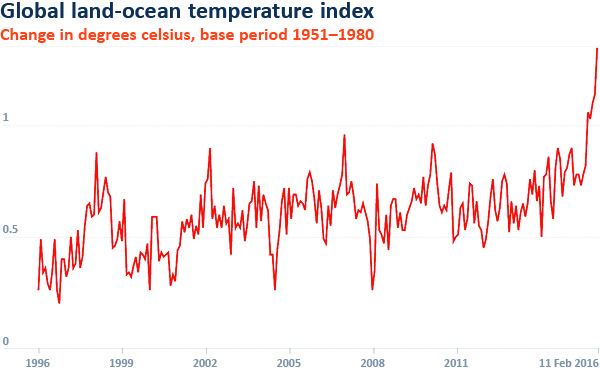
Post-Paris Temperature Tantrum: As if in exasperation with the absence of a radical response to the existential threat posed by 2°, the average global surface temperature in February was 1.35° warmer than the average temperature for the corresponding month between 1951 and 1980, by ‘a far bigger margin than ever seen before.’ chart Guardian
Paris Agreement
The climate action that the New Zealand government agreed to in Paris on 12 December 2015 requires parties to pursue efforts to limit global average temperature increase to 1.5°. But this challenge has just become twice as hard, following the post-Paris finding that fossil fuel use must fall twice as fast as previously thought. Auckland, meanwhile, as the world’s largest Pasifikaas submitted: Pacifika city, has a particular obligation to pursue the 1.5° goal, given the vulnerability of Pacific homelands to global warming. This vulnerability, as evidenced by the damage and deaths sustained by Fiji during Cyclone Winston, is not limited to low-lying atolls—the warmer climate is already bringing more-extreme extreme weather events.
Auckland Council’s Low Carbon Auckland action plan concentrates on the city’s single biggest source of greenhouse gas emissions—the 39% from transport—and addresses its low but increasing use of public transport. The car-centric proposals contained in the draft variation for Te Muri are completely at odds with both the Paris Agreement and Auckland’s climate action plan. Given that the greater Mahurangi regional park estate abuts the northern terminus of the metropolitan transport system, public transport is an imminently viable means by which Te Muri is accessed, via the proposed Mahurangi Coastal Trail.
Tourism in the Auckland region
The $13.5 billion tourism export earnings for the year ended September 2015, surpassed those of the dairy industry, previously the top earner, by $0.5 billion. In the Auckland region, which alone accounts for nearly a third of national tourism expenditure, total expenditure in the year ended March 2015 was $6.5 billion, half from international visitors. With Auckland Regional Parks receiving more than 5 million visits per year, their contribution to the regional economy is clearly considerable.
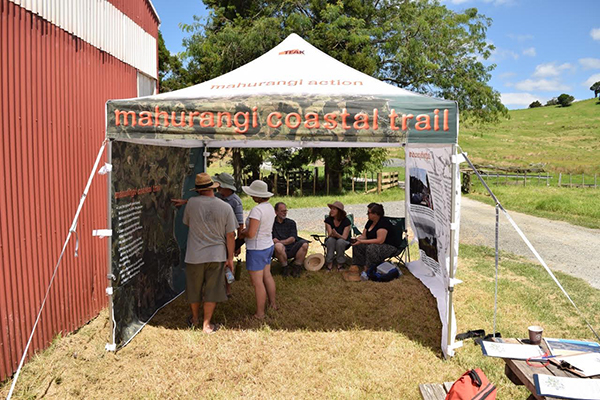
Te Muri to Pūhoi: Mahurangi Action’s gazebo, which does dual duty as the Mahurangi Regatta entries tent and promotion of the Mahurangi Coastal Trail, was also erected at the February Pūhoi Farmers Market promoting the coastal trail and the proposed Te Araroa national walkway connection to Pūhoi, where a further 21 pro forma submissions were signed. Investment in the gazebo’s Mahurangi Coastal Trail content is in recognition that considerably more water may need to go ‘under the Judge Arnold Turner Footbridge’, before this 29-year community initiative is realised. image George Driver Mahurangi Matters
What is also clear, however, is that the contribution of individual regional parks to their local economies is typically less than optimal. This is a reflection of how the car-centric access model funnels visitors to their park destination, and home again, with little or no engagement in the local community. Often the zoning of neighbouring land is a factor, but delivering park users to the interior of a park, by road, rather than to the perimeter, is a recipe for limiting engagement with the surrounding community and economy. The submission of the Pūhoi Community Forum, for example, highlights the economic potential of the village serving as portal to the greater Mahurangi regional park estate.
National walking access goals and Te Araroa, the national walkway
National walking access goals were legislated for with the Walking Access Act 2008, established to:
provide the New Zealand public with free, certain, enduring, and practical walking access to the outdoors (including around the coast and lakes, along rivers, and to public resources) so that the public can enjoy the outdoors…
In particular, the New Zealand Walking Access Commission, established by that legislation, is charged with leading ‘all walking access opportunities in New Zealand.’ Typically, this involves the delicate process of negotiating access over private land. In the case of the proposed Mahurangi Coastal Trail, all the land involved is already in public ownership, yet the variation drafted by its nominal owner, Auckland Council, has not embraced the ‘around the coast’ goal of the legislation.
Te Araroa, the national walkway, is the ultimate national walking access achievement in Aotearoa. Opened at a cost of only $15 million, the same amount paid for just the 383-hectare Schischka farm the year before, it is experiencing an exponential increase in through-walkers—from 60 to 360 per year in 3 years. As the first non-urban section of Te Araroa north of New Zealand’s largest centre of population, the proposed Pūhoi–Te Muri–Wenderholm section would likely quickly become Aucklanders best-known Te Araroa experience, and fill a glaring void in the national walkway.
Public health benefits
With the research of New Zealand-born world-renowned epidemiologist Professor Neil Pearce being reinforced by 2015 British and Japanese studies, it is almost impossible to overstate the public health benefits of public transport. So when the opportunity avails to link public transport, physically, to the additional incentivising of walking, and of cycling and horse riding, it would be perverse in the extreme to persist with a car-only model of regional park access.
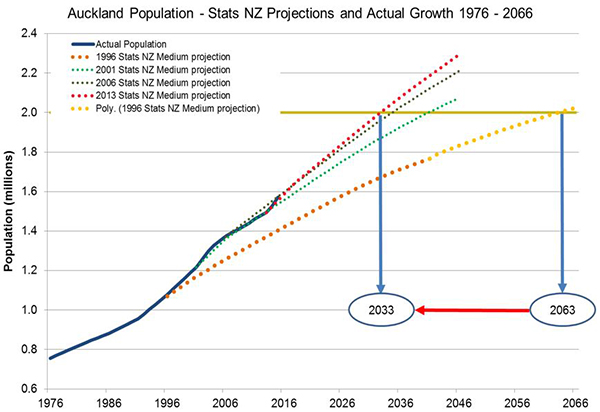
Population Tripled in Regional Parks’ First 50 Years: With a 40 000-hectare network of regional parks in place, all too many Auckland Council politicians fancy the job is done, but to keep pace with the growth likely during the next 50 years, as opposed to the consistently low-balled official projections, a further 50 000 hectares will be needed. This is no time to plan to splurge $10 million building an unnecessary and fervently unwanted road into Te Muri, money that would be much more productively spent purchasing new parkland. chart Transportblog
In their 2013 British Medical Journal editorial, Professor Pearce and co-author Professor Debbie Lawlor identify the need for the fight against noncommunicable diseases to be fought upstream, so that physical activity once more becomes a daily part of life:
…or parks, as in the case of Te Muri.
Population growth and regional parks
Auckland Council, in its unitary plan process, is allowing for the region’s population to increase by one million over the next 30 years. But beyond that, based on current rates of growth, it is probable that the population of the Auckland region will double in the next 50 years—it actually tripledas submitted: trebled. Changed here 30 June 2018 in the previous half century, which calls for existing regional parks to receive twice the number of visits per year—more than 10 million, for the network to be doubled in size—to more than 80 000 hectares—or 90 000, if the regional council’s regional parkland to population ratio was to be maintained, or for something in between. Regardless of what balance of intensification versus expansion is pursued, it is rational that the regional parks, wherever possible, be optimised for people rather than for cars.
Greater Mahurangi regional park estate
The final, critical contextual consideration is that of the greater Mahurangi regional park. The 2010 purchase of the 383-hectare Schischka farm reconfigures two nearby regional parks into one, contiguous, 900-hectare whole. Of the many reasons this wholeness should be embraced and celebrated, the most obvious is scale. Although the smallest of Auckland’s regional parks is a mere 8.37 hectares in area, the average size is more than 1500 hectares, and this scale is a large part of what set regional parks apart from local parks and reserves. They typically provide, for example, for walks of more than an hour’s duration, and for a significant sense of journey, and of wilderness.
Wenderholm, by virtue of its car-centric development style, and Mahurangi West, by virtue of its elongated geography, provide limited ‘depth’ in which visitors can immerse themselves. The addition of Te Muri profoundly changes this by providing the coastal acquisitions with a substantial hinterland, which, by happy coincidence, reaches most of the way towards Pūhoi and the current limit of Te Araroa.
The circumstances by which the greater Mahurangi regional park materialised are as ironic as they are serendipitous. The 383-hectares acquired in 2010 was the residue of the Schischka farm after its high-value coastal margin had been compulsorily purchased under the Public Works Act in 1973, to the considerable and understandable chagrin of the family. That the land was offered as an addition to the Auckland Regional Parks network three and a half decades later was a consequence of the stipulation of the will of Peter Schischka that the property not be subdivided—its gazetting as regional parkland was one of the few ways that requirement could be discharged. This fortuitous circumstance deserves to be saluted by ensuring that the magnitude of the greater Mahurangi regional park estate is honoured by being treated as a whole.
The acquisition should be treated with the reverence it deserves, and not as just another smaller-than-average, independent regional park.
Return to Contents
3 Fewer is greater
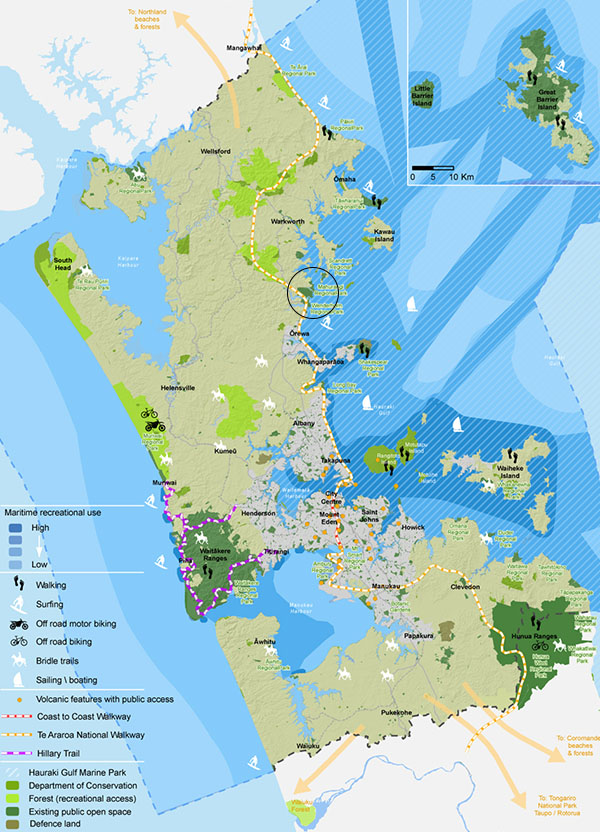
Mahurangi Regional Park Perspective: While a rationalised, greater Mahurangi regional park, circled, would make for the third largest in the network, it would still be dwarfed by either of the more than 19 times larger Hūnua Ranges or Waitākere Ranges regional parks. Currently the third largest regional park, at 843.17 hectares, is Atiu Creek, on the Topuni arm of the Kaipara Harbour. The 383-hectare Peter Schischka farm purchased in 2010 has been added here—it was somehow omitted from this May 2012 map. map Auckland Council
The vision in the draft variation to the Auckland Regional Park management plan in respect to Te Muri begins:
The flaw in the sentence structure sets up the balance of the vision to fail to actually address Mahurangi, Te Muri, and Wenderholm regional parkland as a network. The sentence, logically, should read:
Mahurangi, Te Muri, and Wenderholm regional parkland forms a strategic coastal park network on the north-eastern coast of the region.
More importantly though, the draft vision assumes that the 2010 Te Muri acquisition, along with coastal margin acquired in 1973, must be regarded as separate regional park.
Arguably, when the Mahurangi Regional Park was established, it should have subsumed Wenderholm Regional Park. The historically much wider application of Mahurangi, of course, would have precluded the amalgamated parkland retaining the name Wenderholm Regional Park. This historical misstep now must be addressed, because of its demonstrable effect of obscuring the need to think not merely in terms of network, but of a regional park whole.
The combined area of Mahurangi, Te Muri, and Wenderholm regional parkland estate is a nominal 900 hectares, and is the third largest contiguous area of regional parkland, after those named for the Hūnua and Waitākere ranges. In the context of regional parks, there is no plausible situation in which visitor experience would be enhanced by pretending that contiguous regional parkland is separate parks. Visitors to Wenderholm, for example, regardless of whether Wenderholm Beach is their sole objective, will be enriched by the knowledge that, should they choose to, they can readily explore a further three beaches to the north. And even further enriched when, in the fullness of time once a Mahurangi Harbour ferry is operating, they have the choice of a total of nine beaches.
While the greater Mahurangi regional park estate, at 900 hectares, would form the third largest regional park, it is less than a nineteenth the size of the Waitākere Ranges Regional Park, and even less than a nineteenth the size of the Hūnua Ranges Regional Park. Nowhere else in the Auckland Regional Parks network is contiguous regional parkland constituted as separate parks, nor should it be. Te Muri and Wenderholm, would, of course, always retain their own names and identities, but as locations within the Mahurangi Regional Park, along with, for example, Sullivans Bay and Scotts Point. This latter name, incidentally, needs rectifying to Scotts Landing.
The Mahurangi and Wenderholm regional parks might have been reconstituted as one during any of the subsequent regional parks management plan reviews of the last three decades, but particularly from 1999, when the regional council abandoned the practice of conducting park-by-park processes and began reviewing the entire network collectively, culminating in the 2010 Auckland Regional Parks management plan. Belated as it would be, it is imperative that this variation process, before compounding the anomaly by creating a third regional park, finally addresses this historical misstep.
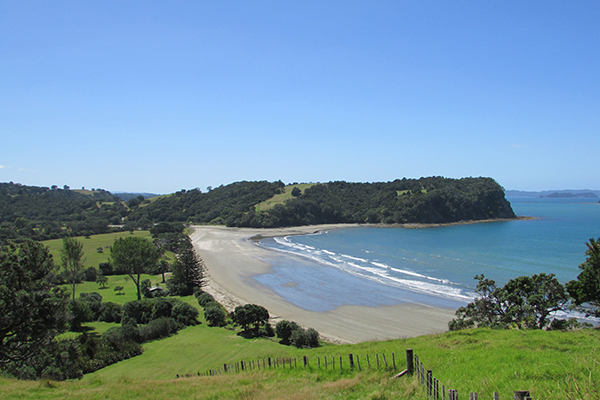
Pūhoi Farmers Market Fans: Among the many who enthused about the Mahurangi Coastal Trail, and strongly opposed general private car access, at the Pūhoi Farmers Market on Sunday was a Red Beach resident who happened to have this Te Muri image on his phone. Twenty-one people signed pro forma submissions and scores more were taken for distribution to friends and family. map Chris Eddy
If for any reason rationalisation is not considered as part of this variation, such as a decision to defer consideration of the question until the review of Auckland Regional Parks management plan due by 2020, the overarching need is for Te Muri’s development to be considered in the context of the greater Mahurangi regional park estate. Any such deferment, however, would represent a dereliction of governance in that it, at the very least, it would potentially incur the not inconsiderable costs of an extra, avoidable round of regional parks re-branding. At worst, however, the failure to soberly consider rationalisation could cloud a vision of Mahurangi, Te Muri and Wenderholm functioning as one cohesive whole.
The most valuable use that the interior, Te Muri heartland can be put to, is providing Aucklanders with 407 hectares of relative solitude, and in a regional park estate that is already serviced by public transport. As will be discussed in more detail later in this submission, retaining that relative isolation does not preclude the harmonious accommodation of significant numbers of visitors. If, alternatively, as proposed in the draft variation, the prime scenic ridge trail is developed as private vehicle access, its literally priceless value to provide respite from urban living, and the contagious camaraderie of trail experiences, will be destroyed.
Since the issue of amalgamation was articulated in the Mahurangi Magazine almost a year ago, in a piece titled Three Separate vs. One Magnificent Mahurangi Regional Park, not one communication has been received objecting to the less-is-more, or more properly, fewer-is-greater, contention.
Mahurangi Action submits that the first duty that must be addressed in the Auckland Regional Parks management plan variation in respect to Te Muri is the rigorous consideration of the implications of rationalising Mahurangi, Te Muri and Wenderholm regional parkland as one, Mahurangi Regional Park.
Return to Contents
4 Exploring Te Muri
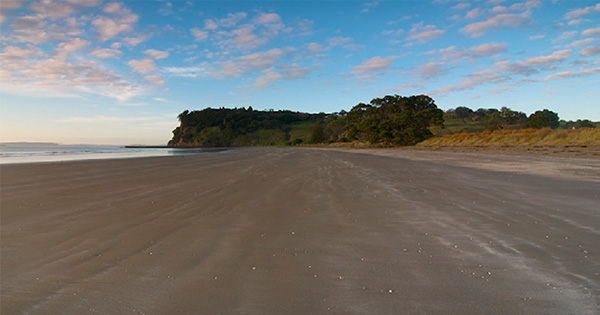
Seven-Hundred-Thousand-Visitor-Per-Year Beach: While it is currently not unusual for visitors to Te Muri to find they have the entire beach to themselves, this will change once the management plan variation currently being formulated takes effect making the parkland considerably more accessible. But most who know Te Muri fervently pray that the target visitor density will never approach that of the kilometre-long Long Bay Regional Park beach that attracts about one million visits per year, which would equate to 700 000 for Te Muri’s 700-metre beach. image Pūhoi Community Forum
In this section, the broad recreational potential of Te Muri is explored, but a prerequisite is a brief review of its geography. Ninety-five percent of the parkland of Te Muri predominantly consists of steep hill country flanks of an east–west ridgeline of an average elevation of about 110 metres, three kilometres in length before descending a further half kilometre to Te Muri Beach. While the southern flanks and spurs fall to the tidal Pūhoi River, the northern flanks and spurs fall, for their most part, to Te Muri Stream, but also into Te Muri Estuary.
The remaining 5%—about 25 hectares—is coastal and estuary terraces. This includes an appreciable area that is otherwise spoken for by farming operations including the woolshed and yards, and by cultural and conservation needs.
Three, not mutually exclusive, prime recreational opportunities are readily apparent. The most obvious is centred on Te Muri Beach and the coastal terrace, but includes the adjoining estuary and its terrace.
The recreational utility of a broad 700-metre-long sandy beach of generally low to medium energy is overwhelmingly obvious—the 1-kilometre-long beach at Long Bay Regional Park attracts nearly one million visits per year. And while the recreational utility of the estuary would not normally be significant compared to the beach, because fording the estuary is currently the only means of readily accessing Te Muri other than by boat, it is considerably used and enjoyed.
The recreational utility of the coastal terrace, much of which averages 150 metres in width, is also obvious, particularly for picnicking and associated day-based recreation such as informal ball games and promenading. The northern 100 metres or more of the terrace, or sandspit, should be protected from any intensive use out of respect for the urupā there, and in consideration of the dotterel and oystercatcher habitat and breeding dunes.
The inshore half or third of the coastal terrace, and all of the estuary terrace—the Nokenoke—suggests itself as optimal backcountry camping space, five or six times the capacity of the current, sometimes cramped, camping ground. While there are a number of other potential camping sites, they probably total only three or four hectares and, not being within immediate walking distance of the beach, are unlikely to appeal to large numbers of campers. Such sites may nevertheless appeal to those who particularly crave solitude, and to Te Araroa through-walkers desperate to break their journey. Both camping and picnicking will be discussed in more detail later.
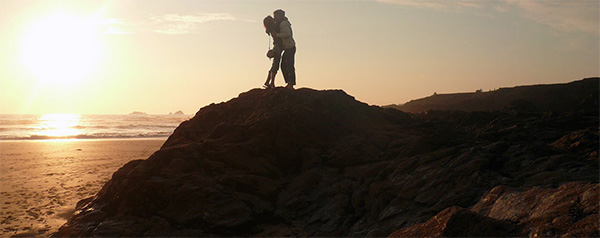
Love the Trail: South West Coast Path promotional image with the pitch ‘If you love the Path, join as a member today’, part of the 4500-kilometre England Coast Path that is planned to be complete by 2020, despite ‘the cuts’. While Aotearoa is yet to begin to emulate a national coastal walk, a 10-kilometre Mahurangi Coastal Trail might help light the way. Contributing £433 000 per kilometre per year to the local economy, the 1014-kilometre South West Coast Path began life as a customs patrol path between lighthouses. image South West Coast Path
The second prime recreational opportunity is the first of two very obvious trail routes, the coastal essentially north–south trail. Coastwise walking has an inarguable appeal, particularly so for the inhabitants of island nations, and indeed is an early human behaviour. The England Coast Path, which is a new National Trail scheduled to be completed in 2020, was made possible by the Marine and Coastal Access Act 2009:
With the coastline between the Waiwera River and the Mahurangi Harbour already in public ownership, ‘enabling the creation of continuous, well signed and managed route’ would seem to be an imminently reasonable and achievable objective.
The third and final prime recreational opportunity is an east–west scenic ridgeline route that runs three kilometres before joining the coastal route for the last half kilometre to Te Muri Beach. The ridgeline route also extends westward beyond the park boundary along the little-used Hungry Creek Road, before dropping into a valley at the confluence of Hungry Creek and the Pūhoi River. The distance from the village of Pūhoi to the regional park boundary is a little more than three kilometres. Given the lack of a terrestrial section of Te Araroa, the national walkway, between Pūhoi and the coast, the availability of the Te Muri ridgeline route is astonishingly serendipitous, and of national importance.
Both the coastal and the Pūhoi routes will be discussed in greater detail, but suffice to suggest here that they would form the backbone of a network of walkways, cycleways, mountain-biking and horse-riding trails that encourage access and enjoyment of much of the 383-hectare Schischka farm that is currently closed to the public.
The particular challenge posed by the development of Te Muri is to ensure that the bulk of the terrain of the 383-hectare Schischka farm, which give or take 3–4 hectares is steep hill country, is suitably used and enjoyed. Mahurangi Action will argue that, aside from any other consideration, relegating the role of the prime scenic ridgeline route to that of an eye-wateringly expensive driveway to the beach for private cars would degrade and restrict every other reasonable option for maximising use of the hill country flanks.
Continued use of the scenic ridgeline route by service vehicles, however, is not detrimental to its optimisation, including as part of Te Araroa. Nor possibly would its use by a limited number of vehicle movements dedicated to the conveyance of disabled passengers.
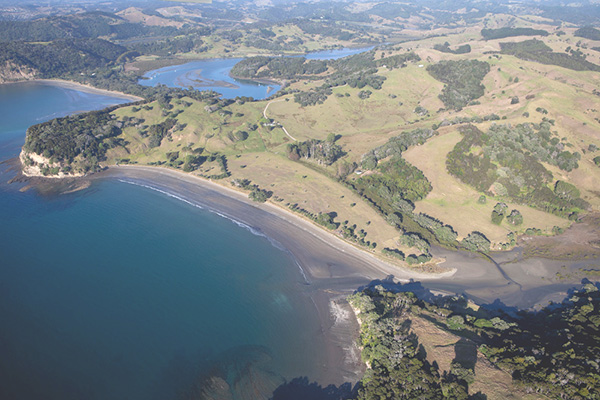
Ephemeral Barrier Beach: It would be tragically ironic if, in an effort to make this isolated beach accessible to private vehicle use, a combination of damage to dunes by foot traffic, and sea-level rise from unabated fossil fuel use, the beach itself, and the prime picnicking and camping land provided by the coastal terrace, was prematurely sacrificed. image Auckland Council
Mahurangi Action submits it is axiomatic that a broad recreational strategy be developed that ensures that the finite 5% of Te Muri parkland adjacent the beach and estuary is not grossly overused, and that the 95% of parkland that is steep hill country is not wastefully underused. This can best be achieved by maximising the potential of both the coastwise and the east–west walking routes, supplemented by bridle, mountain-bike and other parallel and loop trails. Mahurangi Action further submits that the use of the scenic ridgeline route for private vehicle access to the beach as proposed in the draft variation is incompatible with the optimisation for recreation of either the steep hill country or the coastal and estuarine terraces.
Return to Contents
5 Te Muri a beach to protect
Mahurangi Action and at least another 138 phase-2 submitters are responding to the draft variation to the Auckland Regional Park management plan in respect to Te Muri. In the preceding section, the general recreational potential was explored.
In the next section, the picnicking potential of Te Muri is examined. Picnicking is suggested because most visits to Te Muri will be day visits to the beach, and, because of at least a minimal investment of effort to get there, most people will be inclined to linger long enough for sustenance to be a necessary part of the visit. But before any meaningful discussion of beach use can be had, the context of anthropogenic global warming, and in particular anthropogenic sea-level rise, has to be more closely examined.
Te Muri is a low-to-medium-energy barrier beach. As such, its nature is to retreat inland in response to either onshore storm events or sea-level rise. With even a 0.9-metre rise in sea level, east coast Coromandel Peninsula barrier beaches are expected to retreat up to 33 metres. Given the long-term, 15-metre sea-level rise projections for 2° of global warming, the prognosis for dunes and coastal terrace of Te Muri is grim. But in the decades between now and when multi-metre sea-level rise kicks in, whether the barrier beach of Te Muri is allowed to retreat and, eventually, ‘enjoy’ a brief transformation as a pocket beach before its inevitable drowning, will likely depend on the policies included in this management plan variation.
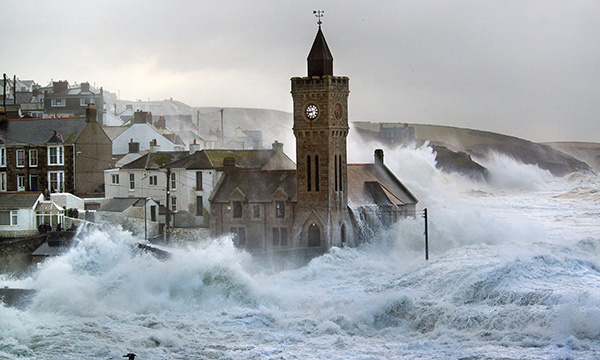
Hard Place: With 45.6% of England’s coast armoured with sea walls, groynes or artificial beaches, compared with a much smaller but possibly closer to the percentage of Ireland’s coast that is defended—7.6%—Aotearoa, if it gets its head around managed retreat, the only plausible long-term sea-level rise strategy available, will buy itself much less grief, particularly once multi-metre sea-level rise kicks in, probably in the latter part of this century. Porthleven, Cornwall, 5 February 2014. image Bernie Pettersen/SWNS.com
The two key policies required to ensure that the beach and dune system have the greatest opportunity to adapt are:
- the establishment and maintenance of an appropriate zonal progression of indigenous species that begins, landward, with coastal forest and culminates in the sand-binding plants of the dunes themselves; and
- the management of the unimpeded landward retreat of the dune system, which includes the beach.
Regardless of the proven soundness of the strategy, its increasing adoption in Australia, the United Kingdom and the United States, and its inevitability as the default response, managed retreat is still not well understood in the context of Aotearoa. Despite both the 2008 Ministry for the Environment Guidance Manual and the 2010 New Zealand Coastal Policy Statement recommending the strategy, the Parliamentary Commissioner for the Environment, in Preparing New Zealand for Rising Seas: Certainty and Uncertainty, suggests:
But where there are no property-holder issues, such as within a regional park, and no expensive-to-relocate built infrastructure, a failure to plan for managed retreat would be patently negligent. The sole significant challenge, of course, is the urupā, which is located on the most vulnerable part of the coastal terrace, in fact within 50 metres of the end of the sandspit. But there is no circumstance where the armouring of Te Muri’s dune shoreline would be viable long term—it would merely hasten the demise of the beach; the heart of the appeal of Te Muri’s adoring public. Any attempt to protect the urupā is doomed to ultimately fail and to risk exposing the human remains and their associated memorials to the indignity of a hasty salvage exercise, following one global-warming fuelled storm surge too many.
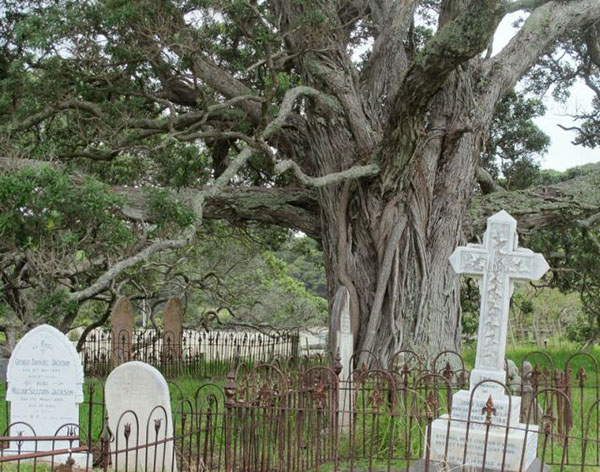
Ultimately Defenceless: With sea level, for 2° of global warming, ultimately projected to rise by 15 metres, the only place for the urupā at Te Muri to go is up, to a hilltop vantage overlooking a muddy bay where once was sandy beach. Even limiting global warming to 1.5°—an impossible task without urgent and radical decarbonisation, of which there is no immediate prospect—wouldn’t be sufficient to save the urupā. image Ross Davies
The frontline brothers-in-arms of a resilient barrier beach are indigenous sand-binding plants such as pīngao and spinifex. The traditional enemies of such sand-binding plants have been grazing stock, and human foot and vehicle traffic. In the case of Te Muri, where the principle goal of the draft management plan variation is to make human access easier, particular attention must be given to ensuring that the increased number of visitors are accommodated with the minimum of damage by foot traffic associated with use of the sandy beach. This suggests that tightly complementary policies will be needed to ensure that beach users have the least impact on the dunes and dune vegetation; these will be discussed in the next two sections.
In light of the vulnerability of Te Muri’s coastal terrace, an entirely valid case could be argued for minimising visitor access. But the alternative—of increasing access and creating an exemplar of informed adaptation to anthropogenic sea-level rise—would fulsomely vindicate the regional parkland acquisition.
Mahurangi Action submits that the first duty of the management plan variation in respect to Te Muri Beach must be to protect and enhance the resilience of the dune system, including by implementing a back-dune revegetation programme that recognises the need to recreate a natural zonal progression across the entirety of the coastal terrace, and to provide for the unimpeded landward retreat of beach and dune system. Mahurangi Action further submits that management plan variation should record the need for an investigation to be begun as a suitable long-term resting place for the human remains and memorials currently contained in the sandspit urupā of Te Muri.
Mahurangi Action additionally submits that prioritising private vehicle access to the beach, as proposed in the draft variation, is incompatible with the duty to nurture the beach, dune system and coastal terrace in the face of anthropogenic sea-level rise.
Return to Contents
6 Primacy of picnicking Te Muri
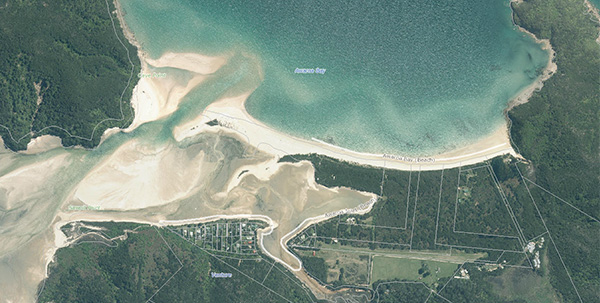
Ragged Retreat: The boundary lines of properties, including that heroically crowd-funded on the Awaroa sandspit, graphically record the shoreward retreat of a barrier beach in response to anthropogenic sea-level rise. While most of the coastal terrace remains intact, its elevation suggests that much of it will be drowned by the end of the century. map Top of the South Maps
In the preceding section, the inherent geomorphology of Te Muri as a barrier beach, and the fundamental need to facilitate the natural response of such a beach to retreat inland when impacted by onshore storm events or sea-level rise, or both, was discussed in order to inform policy on the recreational use of the beach, spit and coastal terrace.
In this section, the picnicking potential of Te Muri is examined. Picnicking is suggested because most visits to Te Muri will be day visits and, regardless of whether the final leg of the journey to Te Muri is by vehicle or otherwise, the time invested will not be inconsiderable, and most visitors will be inclined to linger sufficiently long for sustenance to be a component of the visit. The section might also have been titled Bathing Te Muri, but swimming and other nearshore aquatic recreation invariably involves enjoyment of the dry-sand and dune zones, the protection of which, as outlined in the previous section, is paramount to the longevity of the beach and dune system, and of the coastal terrace itself.
The principal policy that will determine how much pressure is put on the beach and dune system, of course, is whether vehicle access is facilitated, or instead is primarily by foot, cycle or horse. Vehicle access would place the greatest pressure on the beach and dune system, both through sheer volume of foot traffic associated with the high, additional number of attendant visitors, but also because the bulk of that foot traffic would be between vehicle and beach, maximising potentially destructive volumes of traffic through the dune area, taxing the viability of the sensitive sand-binding plants and their stabilising influence. Additionally, the area required to park private cars would substantially diminish the land needed for conservation and recreation, including for camping, which is discussed in the next section.
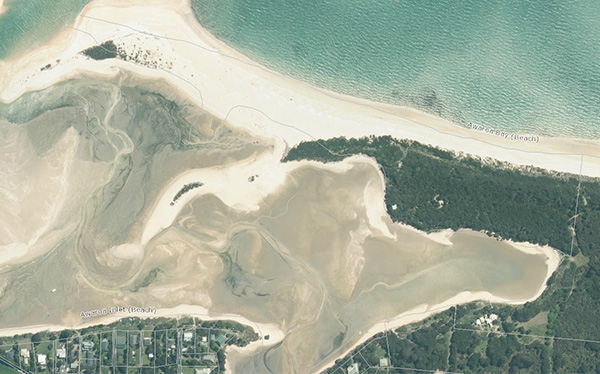
More Vanishing than Retreating: While Awaroa Beach has retreated, the sandspit has disappeared more than it has retreated. Meantime, the esplanade reserve of Awaroa Inlet has halved. In California, rolling easements are being introduced to ensure that the public entitlement to the coastline is not privatised by sea-level rise. map Top of the South Maps
The prime motivation of people visiting Te Muri, whether briefly or as a day or camping visit, will inevitably be to bathe at its beach. With visitor numbers likely to greatly increase as an outcome of the implementation of the management plan variation, with or without private vehicle access, Te Muri Beach will be far more intensively used. Unless effective measures are taken to manage this more intensive use, the current relatively healthy dune system will quickly be degraded, and just at the time that sea-level rise and larger storm-surge events will, increasingly, periodically erode the dunes.
Key to minimising damage to the dune system by recreational use involves incentivising visitors to make greater use of the immediate back-dune zone through the provision of frequent and generous grassed areas for a variety of activities, emphasising picnicking but including, for example, ball games and frisbee throwing, activities that would otherwise be concentrated on the beach. This is particularly important at higher states of the tide, when the area available seaward of the vulnerable sand-binding plants is greatly reduced or absent.
Shade trees will play an important role in providing attractive places for picnicking and other recreation, as would the provision of picnic tables, particularly if Te Muri is optimised for people rather than cars, whereby visitors would be less likely to be equipped with sun umbrellas and camping chairs.
The essential companion provision, to a recreationally attractive back-dune precinct, would be the frequent and appropriately arranged access ‘desire lines’ through the dunes, designed to localise impacts of foot traffic on dune vegetation, whilst minimising wind-caused erosion. At the earliest opportunity, appropriate measures should be trialled to manage human traffic through dune areas, such as an inexpensive and low-key visual guides comprising small-dimension wooden stakes and tape.
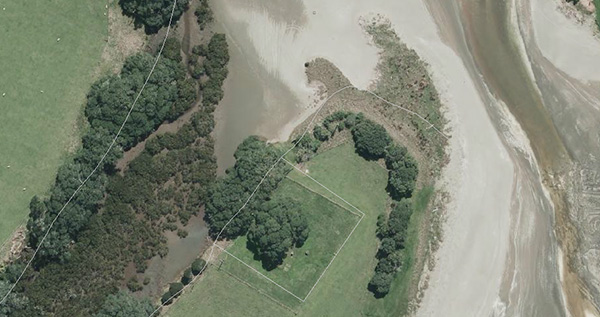
High Tide to Plan for Inevitable: While the landward retreat of the sandspit at Te Muri is nothing as dramatic as at Awaroa Bay, it is time to begin planning for the need to relocate the urupā, rather than wait for the inevitable combination of sea-level-rise-augmented, global-warming-augmented and storm surge coinciding with king tide begins the job regardless. map Auckland Council
Expert input, such as from the Dune Restoration Trust of New Zealand will be necessary to produce a phased planting plan for the coastal terrace, including the area optimised for picnic use, but including that for camping. The first phase would predominantly involve indigenous pioneer species, which would provide the necessary nurse crop for succession species such as pōhutukawa. As has been demonstrated onsite by the failure of specimen trees established decades ago to prosper, the conditions across the currently mostly barren 13-hectare coastal terrace are too harsh for most indigenous succession species without the shelter of pioneer species.
Initially such a planting plan would likely see a high proportion of the coastal terrace revegetated, but as succession trees become established, and as visitor numbers increased over time, larger areas could be returned to grass and recreational use.
Mahurangi Action submits that in order to minimise adverse human impact on the beach and dune system, the coastal terrace should be optimised predominantly for picnicking and other day use, integrated with a long-term revegetation programme as discussed in the previous section, and that no part of the coastal terrace should be given over to car parking. Mahurangi Action further submits that foot traffic between the beach and the terrace must be managed to protect dune vegetation and minimise wind erosion.
Return to Contents
7 Camping Te Muri-style
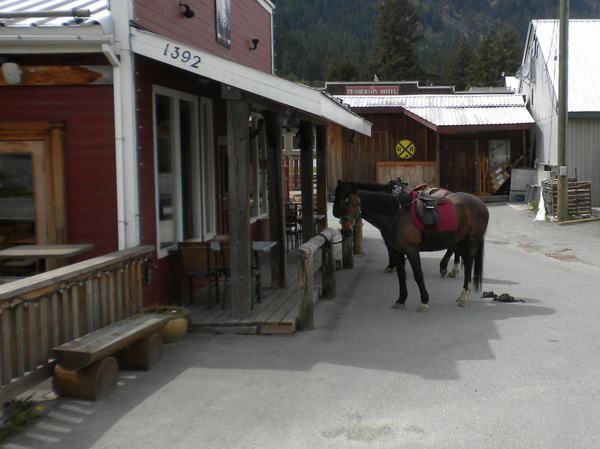
Pūhoi–Te Muri Pony Espresso: Key to encouraging campers to interact with the heartland, and not just the beach and coastal and estuarine terraces, could be a ‘camp store’ overlooking Te Muri Bay, where campers walked for their ordered in supplies and an early morning coffee, or in the cool of the evening for break from camp cooking, dining al fresco at a world-class, car-free restaurant with $15 million view thrown in. But to also lure horse riders from Pūhoi, the water trough absent in this British Columbian establishment would need to be rectified. image TripAdvisor
In this section, the camping potential of Te Muri is examined. Backcountry camping, over the three decades that Te Muri has been open to the public, has been extremely popular with generations of visitors. Although the demand is very seasonal, with more-ready access, the summer demand is likely to be for many times more campsites than provided for in the existing beachside camping ground, which has a maximum capacity of 80 people.
While campers currently mostly enjoy the beachside location—there is an issue with its exposure to onshore winds—the demands of the picnic zone, as described in the previous section, dictate that the camping zone be to landward of the picnicking one, which, to be effective in reducing pressure on the dunes and the beach, needs to be to seaward. Further, the Nokenoke terrace beside the estuary, provides ground very suitable for camping within an easy walk of the beach, and even easier walk of the estuary via a sandy foreshore.
Because of the very limited area of coastal and estuarine terrace for all uses, including camping, it is important that, over time, other camping areas be developed. A campsite near the western park entrance, particularly for Te Araroa walkers desperate to break their journey, is one obvious need. This could be centred on the airstrip, just 300 metres into the park, and which could accommodate 66 people at the density of the current beachside camp.
An established pattern of camping at Te Muri involves parties camping for many consecutive days, and re-provisioning at intervals by walking out to a vehicle parked at the terminus of Ngārewa Drive, then driving to and from Ōrewa or Warkworth. Repeat campers invariably deploy a wheelbarrow or some other wheeled means of carting in supplies. Aside from such logistics having a not insignificant carbon implication, they carry the level of stress and risk that driving in holiday traffic implies, and negotiating an intersection where traffic fatalities have occurred.
Other than Te Araroa walkers, few park visitors would generally be motivated to camp at Te Muri other than on the coastal and estuarine terraces. Further, most campers will concentrate their activities on or near the beach. There is, however, one facility that could reorient the focus of campers, one styled on the once iconic beach campground store, but located half a kilometre back from the beach, overlooking the bay. Operated as a concession or by a not-for-profit to benefit the park and park visitors, it could serve as an agent for retailers in Ōrewa, Waiwera, Pūhoi and Warkworth. Visiting the ‘store’ in the cool of the morning or evening for supplies, and, as a treat, partaking of an espresso or gourmet meal, would encourage campers to experience the rural backdrop to the beach, and take a different route home to the campground and progressively explore more and more of the regional parkland.
The following was published on 21 December 2015 in the Mahurangi Magazine, in an article titled New Parks Czar Delivers Best Possible Te Muri Christmas Present:
…consider a world-class restaurant sited at a strategic location along the old Schischka farm road, accessed by foot and by bridle trail only, and smack on Te Araroa, the national walkway. This would incentivise folk to experience the more rural part of the park, where otherwise few of the visitors—who are there emphatically for the beach—would ever venture. Those camping at Te Muri, for example, of an evening, rather than prepare yet another meal over the camp gas cooker, could take one of the many tracks that would lead up to the ridgeline, 100 metres above sea level. And, after an evening in the incomparable ambience of places that are achievable only after the investment modicum of determination, stroll home to their campsite. Such an establishment would also serve as a welcome watering hole for people walking to Te Muri from Pūhoi.
That, of course should have read: walking or riding… The article attracted no adverse comment. Indeed, only two adverse comments have been received in respect to the total of 49 articles about Te Muri and the Mahurangi Coastal Trail that the Mahurangi Magazine has published since 2008. One possible location would be the site of the plain and somehow incongruous 1970s farmhouse.
The establishment envisaged would also help garner interest in a network of remote, single or small-group, campsites created with a minimum of earthworks along a number of the minor ridges, with their attendant vistas of the Hauraki Gulf, Mahurangi Harbour and Pūhoi River and, of course, of the parkland itself. Such locations are probably more suitable for glamping operations than the coastal and estuarine terraces, where an altogether more egalitarian experience should be facilitated.
Mahurangi Action submits that wilderness camping opportunities should be maximised and largely located on the landward portion of the coastal terrace—yielding first priority to picnicking use—and on the estuarine terrace, and on the old airstrip, the latter particularly for Te Araroa walkers and horse riders. Mahurangi Action further submits that the establishment of a ‘camp store’ accessed from the scenic ridge route by cycle, foot or horse, and by strictly curtailed service vehicles, should be investigated between now and the next general Auckland Regional Parks management plan review.
Return to Contents
8 Mahurangi Coastal Trail
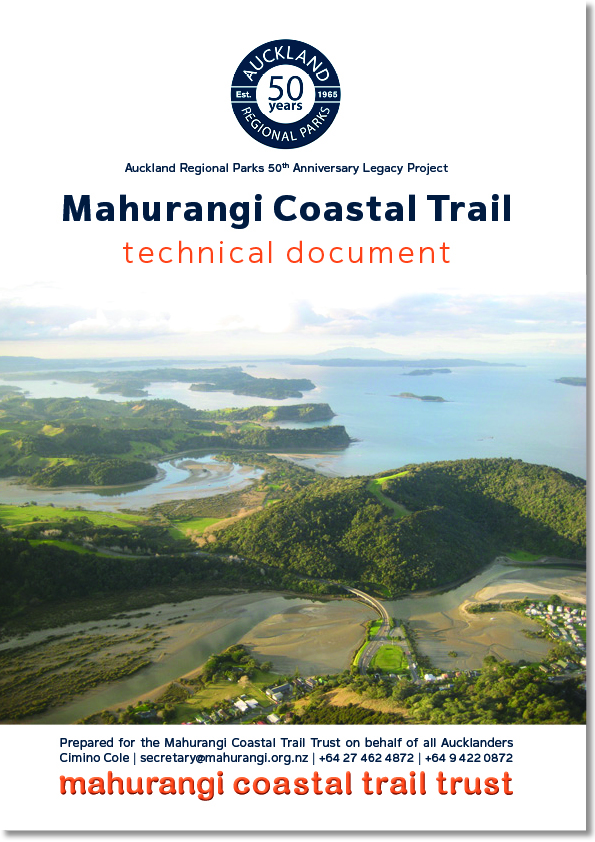
Forming Part of Mahurangi Action’s Submission: The 16-page March 2016 revision of the Mahurangi Coastal Trail Technical Document will form part of Mahurangi Action’s submission on the Auckland Regional Parks management plan variation in respect to Te Muri. Mahurangi Coastal Trail Trust
In this section, the Mahurangi Coastal Trail as the principal means of accessing Te Muri is examined. It is not a new idea. Indeed, a greater Mahurangi coastal trail was formally functioning in the 1870s, and the debate as to who should pay the ferrymen involved is recorded in recorded in Jade River : A History of the Mahurangi:
[Nathaniel] Wilson noted that ‘the Mahurangi ferry was of no special benefit to either the Lower or the Eastern Mahurangi district, but to travellers generally from the North going to Auckland’ … Wilson’s first remark makes it clear that there was a considerable traffic along the coast. Some originated from Mangawhai, or beyond. If one wanted to travel overland, the coast was a much more attractive proposition than the inland. Travellers would have crossed at the Sandspit and passed down the Mahurangi peninsula. I believe the ferry would have operated between Scotts Hotel and Ōpaheke beach or point. Depending on the state of the tide, travellers would probably have followed the shoreline, or Ngārewa Drive ridge, to Ōpaheke and crossed via Te Muri to the Pūhoi on an old Māori track (shown on the Ōpaheke deed). There George Ryan, who lived at the Pūhoi mouth (and had earlier built ships there) would ferry them across.
A contemporary Mahurangi Coastal Trail was suggested in a 1987 submission on the first Mahurangi Regional Park management plan, which successfully proposed a walking-access-only alternative to the then Auckland Regional Authority’s advanced plans for road access from Mahurangi West involving a concrete road bridge across Te Muri Estuary. The authority’s citizens advisory group, chaired by Judge Arnold Turner, was particularly supportive of the walking-access-only concept developed by the community, and there was every expectation that all-tide access would soon be made available.
The regional parks management of the day, having been thwarted in its plans to provide private vehicle access, refused to implement any of the components of the low-impact alternative, disingenuously citing a lack of funding, whereas there had apparently been every expectation of funds for the very much more expensive road access option. Submissions to successive management plan reviews failed to advance the cause of the minor footbridge and boardwalk required to provide all-tide access from Mahurangi West, much less that of the Mahurangi Coastal Trail.
The current proposal for a Mahurangi Coastal Trail dates from the announcement of the purchase of the 383-hectare Schischka farm, in 2010, and the report that:
The new park, including access to Te Muri Bay, will now be accessible by Hungry Creek Rd.
With no mention of the hard-fought campaign of 1987, much less the potential of a Mahurangi Coastal Trail to provide reasonable access for those willing to invest a little effort to reach ‘Auckland’s New Chums’, Mahurangi Action determined that advancing a practicable plan for a coastal trail needed to become the organisation’s priority.
In 2013, civil engineer Roger Williams, learning that Mahurangi Action’s then straightened finances was limiting its ability to progress design of the footbridge necessary for walkers to cross the Pūhoi River, volunteered his services and produced, in 2014, a draft Mahurangi Coastal Trail technical document. This was discussed with council officers and planners and has been continuously developed and revised, particularly following a resource consent pre-application meeting in August last year. The most recent revision, March 2016, of the Mahurangi Coastal Trail Technical Document forms part of this submission, as does the report of landscape architect Jan Woodhouse finding that, in balance, the effects of the proposed footbridge on the environment are less than minor.
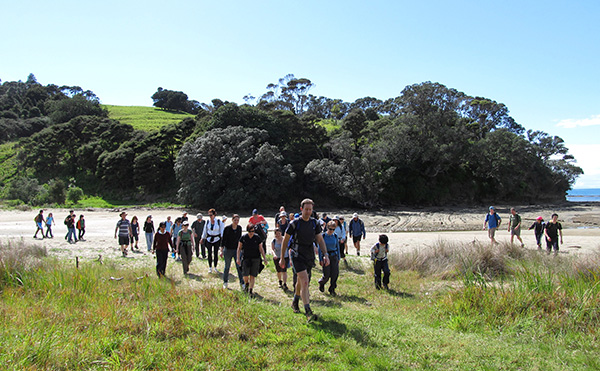
Coastal Trail Would Protect Wildlife: The proposed route for the Mahurangi Coastal Trail deliberately completely by-passes Te Muri’s sensitive sandspit, breeding place of dotterels and oystercatchers, and resting place of godwits. The spit end is also retreating in response to sea-level rise, and needs its dune vegetation to be left undisturbed, not least of all to prolong the period for which it is safe for the nearby urupā to remain in its current location.
The motivation behind the influential 1987 initiative and the current one is the proposition that the sense of splendid isolation that visitors to Te Muri invariably experience should be part of the regional park experience, and that the remote ambiance would be lost if private vehicle access were allowed. With Mahurangi West and Wenderholm readily accessible by road, and subsequently heavily used, the overwhelming wish of the vast majority of visitors to the greater Mahurangi regional park is that Te Muri should provide a more wilderness experience. This view was strongly evident in the first phase of submissions, with only 2 of 140 lodged asking for car access, and most of the balance specifically asking that there be no road access.
While it is known, anecdotally, that a number of submitters wish to see no increase in visitor numbers, the strong level of support for the proposed Mahurangi Coastal Trail indicates that misanthropy is not a significant motivation for wanting Te Muri to be car-free. Where there is ambivalence about the coastal trail, it is often to do with preserving the additional sense of isolation that the incoming tide brings to campers, comfortably ensconced at Te Muri. Access by coastal trail and by Te Araroa, for most, is a very acceptable alternative to private vehicle access, even in the knowledge that visitor numbers will significantly increase.
The proposed Mahurangi Coastal Trail has been designed to provide as gentle a gradient as possible to make Te Muri readily accessible to even people with low levels of fitness and for the elderly, the disabled, and the very young. No steps will be involved, making it readily accessible, including by all-terrain wheelchairs, motor- and hand-powered. Opportunities abound for additional trails, whether bridle, mountain-bike or walking, but the Mahurangi Coastal Trail itself should be as accessible as possible.
A further and not inconsiderable benefit of the proposed Mahurangi Coastal Trail is that its route deliberately and widely by-passes Te Muri’s sensitive sandspit, a recognised breeding place of dotterels and oystercatchers, and resting place of godwits. The spit end is also retreating in response to sea-level rise, and, as previously discussed, the dune vegetation needs to be protected and enhanced, not least of all to prolong the period the nearby urupā can endure remain in its current location.
Due to the comprehensiveness of the Mahurangi Coastal Trail Technical Document that forms part of this submission, details of the proposed coastal trail will not be further expanded here, except to state that the total cost estimated for the recommended options, $1.3 million, is a fraction of the road access alternative, which is believed could be as much as $10 million. With the Mahurangi Coastal Trail Trust confident of raising a substantial part of the estimated $1 million cost of the proposed Judge Arnold Turner Footbridge, and there being no opportunity to develop road access ahead of the opening of the Pūhoi–Warkworth motorway, it would be entirely reasonable for the management plan variation to allow the Mahurangi Coastal Trail to proceed through the resource consent process.
Mahurangi Action submits that the management plan variation should adopt the Mahurangi Coastal Trail concept for providing at least the initial primary access to Te Muri, through to and including the resource consent application and outline-plan-of-works processes.
Return to Contents
9 Te Araroa, the local walkway

Rest is up to Pūhoi: West of the western end of the red line indicating the proposed missing Te Araroa link was best left to the Pūhoi community, which has come up trumps with its unsolicited submission strong supporting the Mahurangi Coastal Trail and Te Araroa connection, and equally strongly opposing private vehicle access. map Parallax Surveyors and Planners
Te Araroa, the national walkway, was opened in 2011 for a total expenditure of $15 million—the year after, but for the same amount, that the 383-hectare Schischka farm was purchased by the Auckland Regional Council, literally as it was being subsumed by Auckland Council. According to Tourism New Zealand:
Studies predicted that the fully open Te Araroa will attract around 100 people annually for the full walk, and about 3000 walkers on multi-day walks. Around 7000 people will walk overnight sections, and 350 000 people will use the trail for day walks.
In fact the January New Zealand Listener story, titled Treasure Trail, reports Te Araroa Trust chief executive Rob Wakelin:
The same article mentions the National Geographic series titled World’s Best Hikes: 20 Dream Trails, in which filmmaker Dan Ransom reports on the trail’s variety:
Te Araroa however, for all the hyperbole, is a work in progress. Through-walkers soon grow to loatheas submitted: loath the on-road sections, for the combination of hard surfaces, camber and the ever-present danger of being struck by a vehicle. This concern was recently highlighted in the Manawatu Standard story Te Araroa Trail Walkers Skip Manawatu:
The on-road parts were unpleasant and uncomfortable, ‘where walkers are often in a ditch or on state highway’.
As a result, a lot of walkers were choosing to skip Manawatu by busing or hitchhiking. Others were getting injured from sustained walking on the road or on camber.
It also meant Palmerston North was missing out, as walkers were often at a stage where they were looking to buy new top-of-the-line gear.
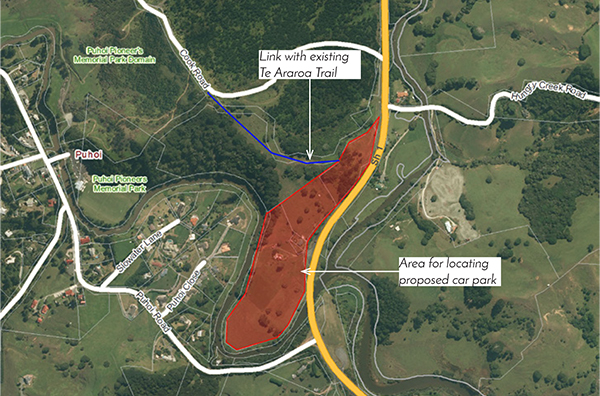
Sorted by the Pūhoi Community: By the insightful integration with the New Zealand Transport Agency’s Ara Tuhono project, the Te Araroa, the national walkway, the Mahurangi Coastal Trail and the interests of Historic Pūhoi Village community, the Pūhoi Community Forum has submitted a compelling alternative to the ruinously costly and compromising draft variation proposal that would despoil a national treasure whilst minimising contribution to the local economy. map Pūhoi Community Forum
Unfortunately, the Pūhoi–Wenderholm section of Te Araroa is an example where walkers typically run the gauntlet of highway traffic and the rigours of roadside walking, unless they choose to canoe that leg—the Pūhoi River being the official, but tide-dependant route:
While some, who have the luck or opportunity to take advantage of an outgoing tide and the hire of a kayak, the majority of through-walkers elect to walk the highway, acutely conscious of the need to stick to schedule and budget—discretionary spending when only 530.5 kilometres into a 3000-kilometre journey is a critical consideration. Lamentably, such walkers generally miss experiencing Wenderholm, and its breath-taking cliff-top Maungatauhoro track.
The reason that there is currently no terrestrial Te Araroa section between Pūhoi and Wenderholm is that key property holders on the south bank of the Pūhoi River, the preconceived route, refuse to allow right of way. This, in retrospect, might now be seen as a blessing, given that since the route for Te Araroa was determined, the Schischka farm was added to the regional parks network, thus opening up the opportunity for walkers to enjoy spectacular panoramas of the Pūhoi River, Mahurangi Harbour and Hauraki Gulf from the ridgeline farm road, as they approach the coast.
But even with a continuing exponential increase of numbers, through-walkers will only ever constitute a very small proportion of the total number of Te Araroa users—0.03%, if the aforementioned projections prove to be accurate. The proposed Pūhoi–Wenderholm section of Te Araroa would mostly be used by Aucklanders as part of a day walk, or as envisaged by a very supportive proprietors of Pūhoi River Canoe Hire, as a canoe-one-direction-with-the-tide, and walk-the-other-direction activity. Given its proximity to New Zealand’s main centre of population, and that it would be the first non-urban section north of the metropolis, the number of people using the Mahurangi Coastal Trail or the Pūhoi–Wenderholm section facilitated by it, could, in time, exceed the 50 000 per year who walk Queen Charlotte Track, in the Marlborough Sounds.
Whilst the 6-kilometre—or 12-kilometre return—journey would possibly tax the range of electric all-terrain wheelchairs, the ‘camp store’ service vehicle mentioned earlier could perform dual duty as a regular, and by arrangement, conveyance for disabled or very elderly visitors.
As submitted in the first phase of public input, the New Zealand Horse Network desires access to regional parks, as opposed to horse-float access into parks. In the context of the proposed new Te Araroa section, this suggests that providing parking for horse trucks and floats at Pūhoi, allowing equestrians to ride into the park, is greatly preferable to providing parking within the regional park, and creating a hazardous conflict of use between walkers and vehicles towing horse floats attempting to negotiate the steep and tortuous Hungry Creek Road.
Mahurangi Action submits that it is in the national, regional and local interest for management plan variation to prioritise the development, subject to gaining resource consent and outline-plan-of-works approvals, of the proposed Mahurangi Coastal Trail thus facilitating the creation of the missing terrestrial Pūhoi–Te Muri section of Te Araroa, the national walkway. Mahurangi Action further submits that the use of Hungry Creek Road and the scenic ridgeline farm road for private vehicle access to Te Muri is irreconcilably incompatible with its potential to form Aucklanders’ most loved and best used sections of New Zealand’s national walkway.
Return to Contents
10 Mahurangi Regatta Week
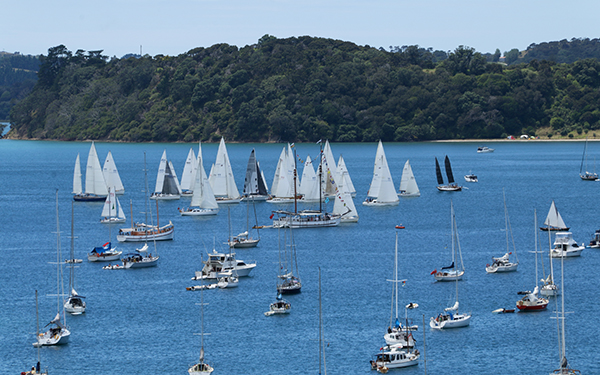
Te Muri Campers in the Gods: Te Muri Walkers and campers would find themselves in the Gods of Sullivans Bay, whose hillsides overlooking the regatta start line form an immense natural amphitheatre from which to view the Mahurangi Regatta. map Parallax Surveyors and Planners
The first Mahurangi Regatta is not recorded. Mahurangi’s first possibly dates from the establishment of Gordon Browne’s spar station in the harbour, in 1832, or more probably, from when HMS Buffalo called in 1834—spoiling things, in Browne’s opinion, by paying local Māori too much for their labours extracting kauri spars. In any event, as Dr Ronald H Locker writes in Jade River: A History of the Mahurangi:
Joseph Gard noted in his diary that he saw the event in progress on New Year’s Day, 1858, while passing up-river on his way home from Auckland.
The Mahurangi Regatta effectively lapsed during World War Two but was revived in 1977, by Mahurangi Action, and the instant popularity of the revived regatta determined that its destiny as an annual fixture was inescapable.
For many who annually attend the Mahurangi and Auckland regattas, Auckland Anniversary weekend is bigger than Christmas. It is a weekend in which Mahurangi Harbour is transformed from a paradisiacal backwater, into a maritime spectacle, featuring what is believed to be the largest one-day gathering of classic wooden boats, supported by a host contemporary craft and thousands of shoreside spectators. Aucklanders living locally, in the city, and in other parts of the region, and visitors from farther afield and internationally, join together for a glorious celebration of sail, and of what for many is their favourite Auckland-region place—Mahurangi.
Since its revival, the event has grown year after year, beautifully bookending, on the Saturday of Auckland Anniversary weekend, the regatta of that name held on the Monday. A large part of the popularity of the Mahurangi Regatta is due to its shoreside events taking place in one of Auckland’s most-loved regional parks—Mahurangi Regional Park. A singular Mahurangi Regatta experience is of those park visitors who, at Sullivans Bay, happen upon the regatta and are drawn into it, with their children joyously participating as heat after heat of evergreen contests such as three-legged, sack, and spud-and-spoon races play out, and team up to passionately create imaginative sand sculptures.
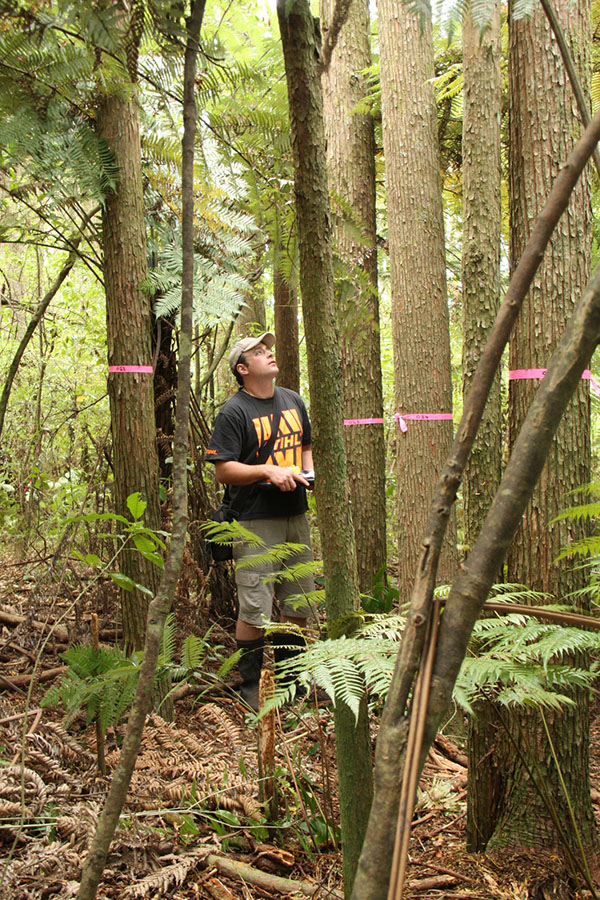
Sustainable Indigenous Farm-Forestry: Rural landscapes might support much more indigenous forest if the choices were broadened from strictly conservation to include such practices as continuous canopy forestry. Here tōtara regrowth is measured in preparation for thinning, which will allow the premium specimens to prosper, rather the members of an overcrowded stand to hold each other back in nature’s race to starve the opposition of sunlight. map Parallax Surveyors and Planners
The after-match function takes place at Scotts Landing, with an 18-piece swing band playing in a marquee beside the historic Scott Homestead. The event is free to locals and regatta-goers, and, again, to accidental participants, as is appropriate in a regional park on a long weekend. The 1940s big band music, and the 1800s ambience of the Scott Homestead setting, make for a decorous and partner-and-family-friendly evening enjoyed by all ages. A familiar lament from visiting yacht and boating clubs is the absence of an equivalent event, following the Auckland Anniversary Regatta.
The potential of the Mahurangi Regatta to receive official recognition as a significant regional has recently been analysed by Auckland Tourism, Events and Economic Development, thanks to the advocacy of the Rodney Local Board. As a one-day event, the Mahurangi Regatta would struggle to meet the agency’s threshold for support, but as a regatta week its prospects, in time, look promising. A key limiting factor, however, is the lack of accommodation in Warkworth and the wider Mahurangi area that might allow a Mahurangi Regatta Week to grow appreciably. But this is where Te Muri could play a pivotal role with its potential capacity to host a weeklong ‘big Mahurangi Regatta Week campout’, with the airstrip, Spaniards Creek and Wenderholm camping potential all contributing. Auckland Council’s popular Music in Parks programme is expected to play a key supporting role.
The Mahurangi Regatta has the potential to involve many more than the current attendance, estimated to be in the vicinity of 3000 shoreside and on the water, but only if the additional people arrive by other than private car, such as by ferry and by special buses operating from Waiwera and Warkworth. The most prestigious way to attend the Mahurangi Regatta, short of under sail of course, would be by walking the Mahurangi Coastal Trail, after bussing to Waiwera, and catching a refreshing swim in the pristine waters of Te Muri. Walkers and campers would find themselves in the Gods of Sullivans Bay, whose hillsides overlooking the regatta start line form an immense natural amphitheatre.
Mahurangi Action submits that the management plan variation should include a policy that the potential for Te Muri to host a weeklong ‘Mahurangi Regatta Week big campout’ be investigated.
Return to Contents
11 Indigenous farm-forestry
Until European settlement, Te Muri, like much of Aotearoa, was mostly forested. There is now a rapidly growing determination to restore some of that estate, and that indigenous forestry can restore much of the lost biodiversity, without abandoning opportunity for economic return. Parts of Te Muri would make excellent demonstration sites for planted indigenous forestry, particularly given its proximity to New Zealand’s largest urban settlement. Indigenous forestry is a natural fit with the regional parks working-farm-park model, and would meaningfully complement existing regrowth and new plantings, which exist for purely conservation purposes. Farm forestry of indigenous species would be fully compatible with the North-West Wildlink concept, and its extension to Scandretts, Kawau and Tāwharanui, and on to Little Barrier.
Mahurangi Action submits that a role for indigenous forestry should be investigated at Te Muri.
Return to Contents
12 Mahurangi marine reserve
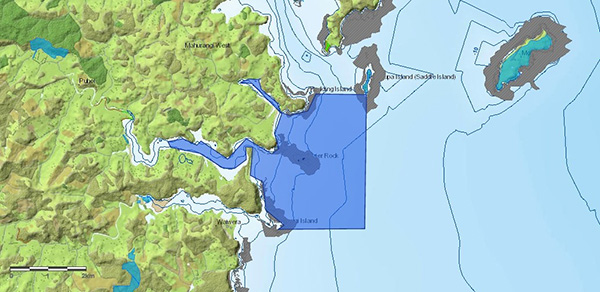
Natural Sentinel Option: This concept for a 944-hectare Mahurangi marine reserve nicely utilises the natural sentinels provided by Pudding, Saddle and Mahurangi islands. It is one of a number of areas identified by Dr Roger Grace in his Hauraki Gulf marine spatial plan role—it is currently before the stakeholders working group—that, combined, would nevertheless occupy only a very small percentage of the total gulf coastline. concept map Dr Roger Grace
With the successful upgrading of the marine park at Tāwharanui to a full marine reserve, the increasing expectation of visitors is for marine protection to be part of the regional parks experience. In 1991, a questionnaire circulated by Mahurangi Action to its members and to 3000 households in the wider Mahurangi area found 82% of respondents volunteering that by 25 years hence—by 2016—they wanted a no-take marine reserve to occupy all or part of the Mahurangi Harbour, and the coastline of Te Muri and Wenderholm. The 1992 joint submission to the Mahurangi Regional Park management plan, by Forest and Bird, iwi, Mahurangi Action and the Mahurangi West Residents and Ratepayers Association, included:
The possibility of establishing a no-take marine reserve [that] included areas of the Mahurangi and Wenderholm regional parks should be discussed with all interested parties.
This review of the Auckland Regional Parks management plan is an appropriate time to invite discussion of a Mahurangi marine reserve, and its potential boundaries, such as between the natural sentinels of: Pudding Island, off Cudlip Point; and Mahurangi Island, off Waiwera.
Mahurangi Action submits that iwi should be consulted regarding the possible establishment of a marine reserve off part or all of the coastline of the Mahurangi, Te Muri and Wenderholm regional parkland, with view to an investigation of Mahurangi marine reserve concepts forming part of this planning process, or of the general management plan review in 2020.
Return to Contents
Conclusion Te Muri, legacy project
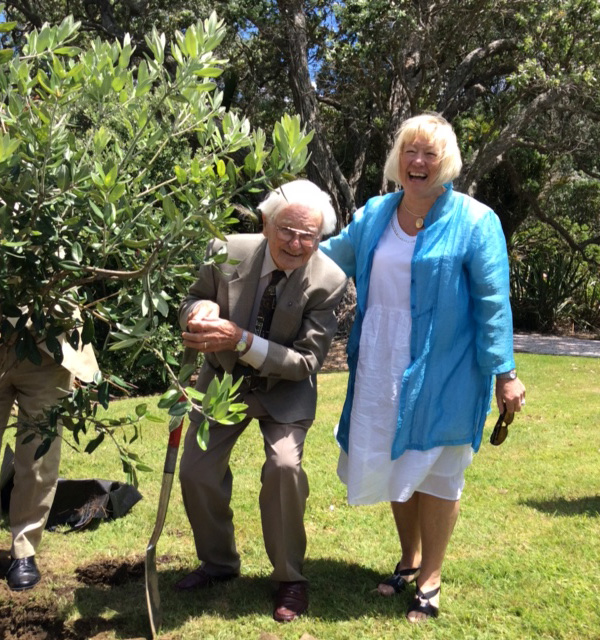
First and Current Chairs: Judge Arnold Turner, ducking for the photographer, and Councillor Christine Fletcher at the 50th anniversary of the opening of Wenderholm Regional Park. Arnold Turner CMG, then a planning lawyer, was effectively first chairman of regional parks, while Christine Fletcher is the present, chairing Auckland Council’s parks, recreation and sport committee. Whether the latter will do justice to the former may well come to be measured by whether the Mahurangi Coastal Trail, with its proposed Judge Arnold Turner Footbridge, becomes the Auckland Regional Parks 50th anniversary legacy project. image Bronwen Turner
As stated at the beginning of this submission, the Auckland Regional Parks 50th anniversary celebrations are part of the context of the management plan variation in respect to Te Muri. In many ways it is the least important of the six contextual considerations listed. In comparison to the likely growth of the Auckland region over the next 50 years, for example, it is of symbolic importance only, nor can it begin to be compared to the clear and present danger of anthropogenic global warming, with February’s record increase of 1.35°:
But precisely because of the power of its symbolism, the 50-year milestone presents an excuse to be bold and visionary when planning the development of Te Muri. Rather than more of the same car-centric thinking that has landed New Zealanders with a diabolically difficult challenge of addressing their biggest source of greenhouse gas emissions—the 39% from transport—Te Muri presents an opportunity to demonstrate how regional parks can be part of the solution, which indubitably requires a dramatic shift towards public transport.
The meteoric rise in bus transport since the commissioning of the Northern Busway, including the exponential growth in passengers boarding at Silverdale since the opening of the Hibiscus Coast Station, is testimony to how readily commuters will vote with their feet if the alternative is sitting, fuming, in barely-moving motorway traffic.
If there were no insurmountable safety issues, which there are until such time the Pūhoi–Warkworth motorway is opened, or no budgetary constraints, which there are for the foreseeable future, a decision by Auckland Council to access Te Muri by road, despite it being contrary to the goals of its Low Carbon Auckland action plan, could perhaps be excused as an unremarkable failure to consider future generations. But given that road access can’t usefully be advanced at this time, the reasonable course of action is to embrace the community’s passion for a Mahurangi Coastal Trail to be the initial, prime means of access, and to reassess the need to investigate road access at the 10-year review of the Auckland Regional Parks management plan, in 2020.
With the coastal and estuarine terraces of Te Muri likely to be lost to sea-level rise before 2100, Auckland Council has a particular duty to ensure that today’s planning decisions for the regional parkland prove to be a proud, rather than foolish, legacy.
Mahurangi Action submits that the management plan variation in respect to Te Muri should honour the occasion of the Auckland Regional Parks 50th anniversary by embracing a strategy of maximising cycling, horse riding and walking opportunities, and access by public transport, by developing the proposed Mahurangi Coastal Trail and facilitating a terrestrial Pūhoi–Te Muri Te Araroa link, and thus demonstrating a sustainable model for regional park access appropriate for the next 50 years.
